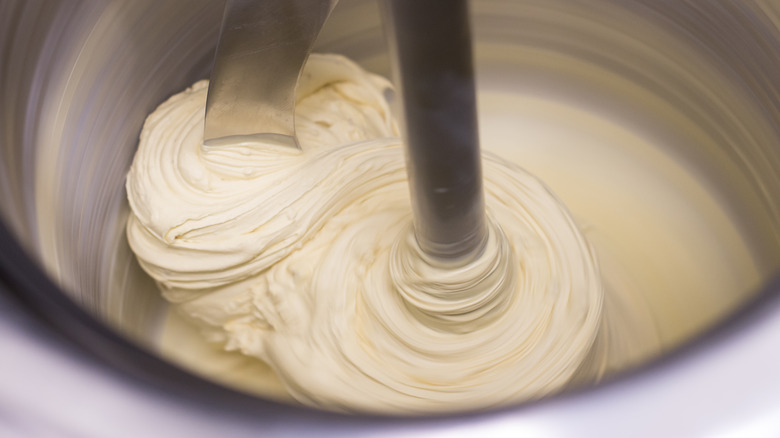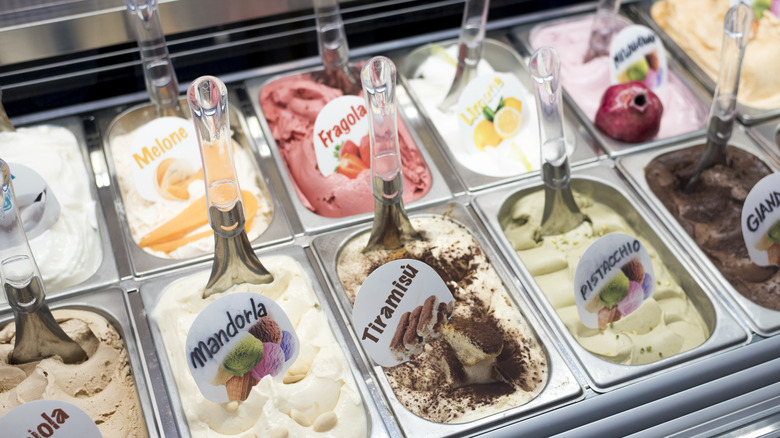The Creamy Difference Between Gelato And Ice Cream
Ice cream in one form or another has been around for a very long time; the earliest documented version was created in China in the first millenium. Fast forward to the 21st century, and there are so many variations on the frozen treat theme that it's hard to count them all up: sorbet, granita, frozen custard, frozen yogurt, soft serve, ices, and kulfi, to name a few.
The two that often get confused, however, are gelato and ice cream. Although not as ancient as ice cream, gelato still has a few centuries under its belt. The uniquely Italian frozen dairy treat was developed in the 1600s as a dessert for the wealthy and elite. By the end of the century, the commoners had developed a taste for it, too.
At first glance these sweet bites may not look that different from one another; both ice cream and gelato can be flavored in infinite ways with additions of candies, fruit, chocolate, and nuts. They can be served in a dish or scooped and stacked high on a cone. And of course, they're both frozen, creamy, refreshing, and dang delicious. However, they are in fact two different creations.
There are a few factors that set gelato and ice cream apart, but the most important one is the liquid base used to create them. For ice cream it's right there in the name: cream. Gelato on the other hand is made with milk. It seems like a relatively small distinction, but it really makes such a difference once these treats are churned into their final, frozen form.
The fat is what makes the difference
Because gelato is made primarily using whole milk instead of cream, it has less fat than ice cream, typically between 4% to 9%, according to a 2009 study. Depending on the brand or on the gelateria, some gelatos may contain a small amount of cream, but milk still makes up most of the liquid base.
The opposite is true when it comes to ice cream: that cream is perhaps the most important ingredient. The United States Department of Agriculture requires that ice cream contains at least ten percent milk fat, but the amount is often higher. According to Forbes, premium ice cream brands like Ben & Jerry's have 16% milk fat or even more. Many ice creams are also made with egg yolks, which are slowly cooked with the cream to make a custard-like base.
The higher fat content of ice cream gives it a creamy, rich, and even buttery texture – one of the things we love about it. That fat also mutes the flavors in ice cream somewhat, making them less intense than in gelato, but lots of sugar and concentrated flavorings mean that ice cream still tastes delicious. And as far as flavors go, with ice cream the sky is the limit; old-fashioned ice cream flavors like vanilla, mint chocolate chip, and butter rum are still popular, as are more wild creations that include savory flavors like macaroni and cheese.
As for gelato, its lower fat content allows flavors — whether fruit, chocolate, or nuts — to come through more vibrantly than in ice cream. As such, it's often naturally flavored. Although you can find gelato with creative ingredient combinations too, traditional (and still very popular) Italian flavors include stracciatella (chocolate chip,) almond, lemon, gianduja (hazelnut with chocolate,) and pistachio.
How air further affects the texture of gelato and ice cream
How ice cream and gelato are mixed also contributes to their unique textures. Ice cream is churned with the goal of incorporating lots of air, called overrun by ice cream makers, according to the book, "Ice Cream." The amount varies, but soft serve and lower-quality ice creams contain as much as 95–100% air while premium ice cream brands are less than 30%. By contrast, low air content is a defining characteristic of gelato. A slower churning process means that the amount of air in gelato is about the same as that of premium ice cream, however, the higher fat content of ice cream still sets them apart.
This difference in air content ultimately affects the texture of each product — less overrun (i.e. less air) results in a creamier end product. As such, authentic gelato is heavy, silky, and dense, which some even describe as having a stretchy quality. Some recipes even include egg yolks for added richness. Ice cream, on the other hand, is lighter and thinner. Still, it offers a wonderful, filling butteriness that lingers in the mouth with each bite and a fantastic base for any number of wild flavor combinations.
Ultimately, enjoy your gelato; enjoy your ice cream — they're both indulgent and flavorful desserts that will more than satisfy your sweet tooth. Just don't say that they're the same thing!


